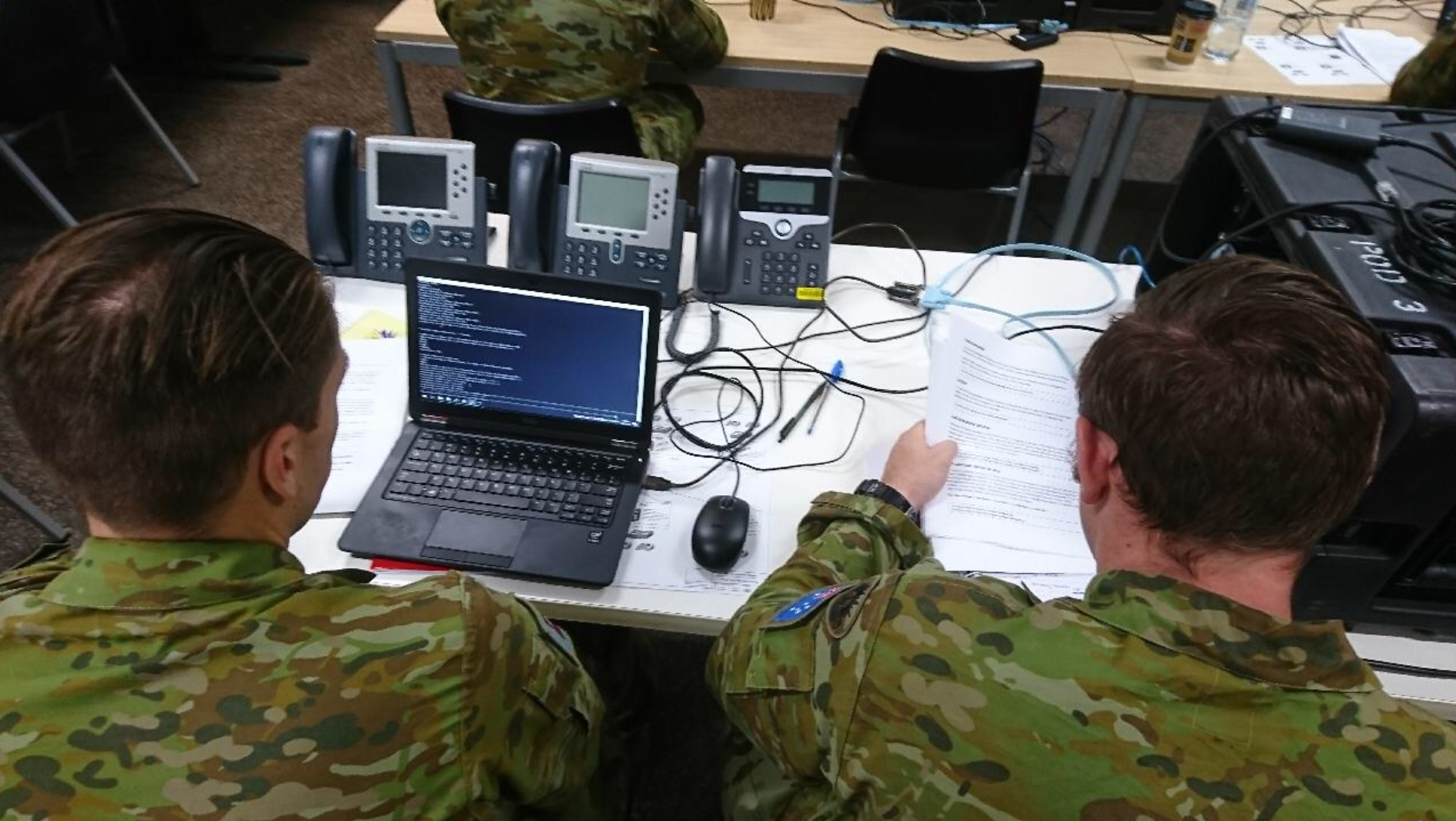Introduction
Voice communications is essential to effective Command and Control (C2) in the Australian Defence Force (ADF). In the deployed environment, Secret Voice over Internet Protocol (SVoIP) is the primary means to achieve this. It is also the ADF approved network for coalition interoperability. Yet, the specific engineering required has never been supported through formal training. This skill set is pivotal for effective provisioning and maintenance of the network. To address this, the SVoIP helpdesk at DEFCOMSTA Melbourne (DCS-M, manned by uniformed personnel) developed a just-in-time workshop to refresh and augment previously trained skills for personnel about to deploy.
You wouldn’t expect a soldier to be sent into an operational environment without conducting weapons familiarisation. This should be no different for communicators being deployed on operations.
History
The deployed communications networks of the ADF are vast, immensely complex, and span continents. While the underpinning technologies are trained as part of initial employment, the adaptation to a specific deployed environment is not.
To contextualise, take the example of a soldier trained on a weapon upon joining the ADF. The soldier may not be required to use this skill for an extended period of time, however when required, the basic requirement does not change, albeit refresher training is provided. This addresses the physical realm. By contrast a communicator is required to operate weapons in the digital realm, as well as the physical. However, appropriate refreshing in the primary C2 network does not occur for communicators. This can be the cause of an increase in incidents, both in terms of frequency and duration, resulting in degraded services to deployed personnel. This degradation has affected interoperability between coalition partners.
The solution
An increase in incidents was identified by the SVoIP helpdesk from deployed units over the past few years. This was recognised as being due to a lack of specific skills in the deployed space. In short, the VoIP training received at initial employment could not be adapted to the specific deployed environment, noting the ADF’s intent in preparing for “a war, not the war”. To bridge this skill gap, the helpdesk developed a just-in-time workshop to refresh and augment previously trained skills for personnel about to deploy. This was also identified by units as the single opportunity to address this skills gap prior to arrival in theatre.
This workshop comprises a suite of commercial-off-the-shelf (COTS) equipment, emulating specific deployed networks. This is an unclassified, standalone network, which removes the handling and delivery requirement associated with classified environments. Mistakes on operational networks can result in communications outages – impeding effective C2 – and disciplinary action; this often prevents maintainers from innovation in how they engineer and manage their networks. The standalone nature of the workshop affords participants a sandbox environment in which to fail without consequences to deployed forces.

It has been trialled, reviewed through participant feedback and re-delivered for several years. It has the agility to be redirected to meet unit requirements on a case by case basis, therefore is adaptable to “a war, not the war”. The suite is modular and transportable, allowing delivery to be at any unit’s location. As an informal workshop the content can be updated with minimal delay to ensure contemporary relevance to deploying forces.
The workshop is currently delivered by the SVoIP helpdesk personnel with contemporary operational and strategic experience, which ensures deploying communicators are refreshed in their digital weapon, allowing them to engineer and maintain their primary C2 networks in support of deployed forces.
Endstate
The workshop was developed due to an identified skill gap which remains extant. However, this has never been a specified task for DCS-M. Originally targeted to units about to deploy, it has grown to be included as part of annual induction and trade refresh by units across the ADF. This workshop is no longer sustainable organically, as DCS-M is not resourced to meet this growing demand.
As a trialled, reviewed and re-delivered capability, the workshop has gained the maturity to be officially allocated to a more appropriate organisation for ongoing delivery. Assistance is sought for a formal solution to be identified to ensure this valuable capability is sustained into the future.
About the authors
Geoffrey McMillan completed Initial Employment Training (IET) at the Defence Force School of Signals (DFSS) in April 2015 and commenced his full-time military career at Defence Communications Station Melbourne (DCS-M) immediately after. Whilst at DCS-M Geoffrey studied many technical courses, which allowed him to become a member of the DSVN Helpdesk. During his tenure at the Helpdesk Geoffrey assisted with the continuing growth of the Strategic Voice Network, maintenance of the Cisco Unified Border Elements (Enterprise level communications equipment), and ongoing changes and upgrades to the Cisco Unified Call Manager. Geoffrey has developed extensive knowledge of the Strategic side of the DSVN.
David Ashmore and Bryan Masters completed their IET at DFSS in 2005 and 2008 respectively. Between them they have many years served in Combat Signals Regiments (CSRs) as well as specialised units and positions. They have attended varied technical courses, acquiring skills, experiences and a wealth of knowledge from the different roles and responsibilities at their previous posted units; both domestic and abroad. David and Bryan bought their combined experiences to DCS-M in January 2015, to work in the DSVN Helpdesk helping to shape the DSVN Workshop to reflect current deployed requirements.
Geoffrey, Bryan and David will no longer be able to work on the DSVN Workshop due to posting cycles and the re-direction of DCS-M role.


